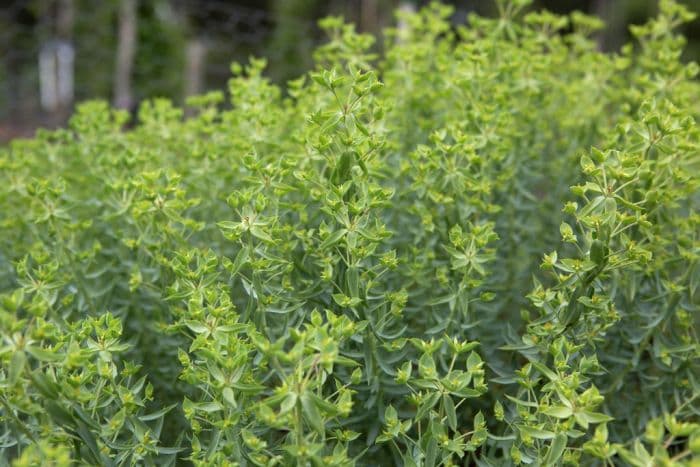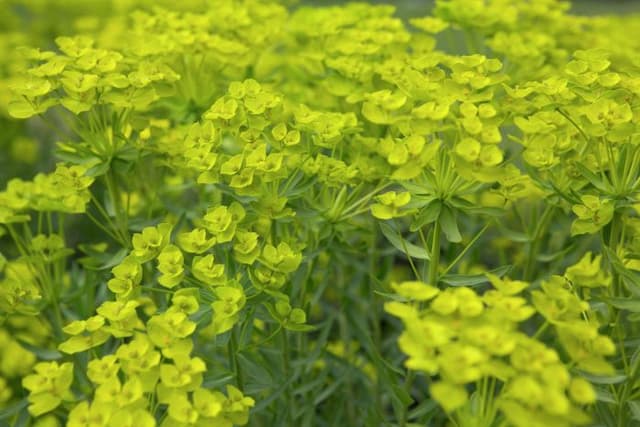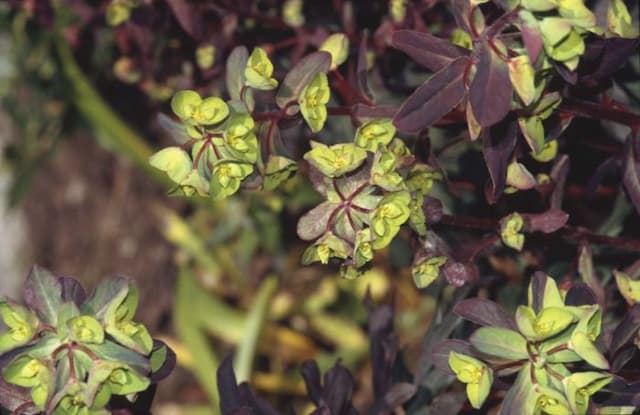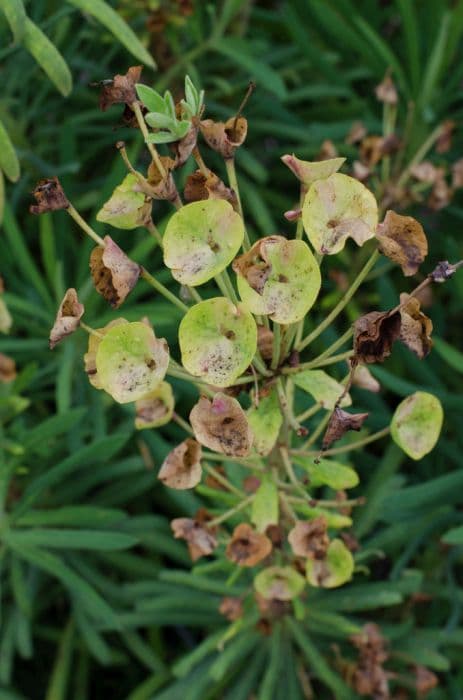Pine Spurge Euphorbia pithyusa

ABOUT
The plant in question, commonly known as the Petty Spurge, exhibits a distinct appearance characterized by its branching habit and overall greenish tone. It is adorned with narrow, elongated leaves that spread out from the central stem, creating a somewhat sparse and airy look. Each leaf is fairly small, with smooth edges, presenting a soft, matte finish rather than a glossy sheen. The Petty Spurge blooms with tiny, inconspicuous flowers that may be easily overlooked. These flowers are clustered within cup-like structures called cyathia, which is a typical feature of plants within this genus. The cyathia are often edged with subtle, petal-like appendages that can be a lighter green compared to the rest of the plant, adding a delicate contrast to the overall color scheme. The stems of the Petty Spurge exude a milky sap when cut or broken. This sap is a notable characteristic of the plant, but it is important to be aware that it can be irritating to the skin and toxic if ingested. In terms of growth habit, the Petty Spurge is a bit sprawling, tending to branch out and occupy the space around it with a somewhat casual demeanor. It is not a particularly structured plant, which may give it a relaxed or unkempt look depending on the setting in which it is growing. Overall, the Petty Spurge can have a subdued presence in the landscape, often blending with other green foliage unless closely inspected for its unique structural attributes and the intricate details of its flowers and cyathia.
About this plant
 Names
NamesFamily
Euphorbiaceae
Synonyms
Mediterranean Spurge
Common names
Tithymalus pithyusa, Euphorbia mediterranea, Euphorbia pinea.
 Toxicity
ToxicityTo humans
Euphorbia pithyusa, commonly known as Mediterranean spurge, contains a toxic white sap found throughout the plant. This sap is a skin and eye irritant, and if it comes into contact with the skin, it can cause redness, swelling, blisters, and severe dermatitis in sensitive individuals. If ingested, the sap can cause irritation to the mouth, throat, and stomach, leading to symptoms such as nausea, vomiting, and diarrhea. Ingesting substantial quantities could result in more severe reactions, potentially leading to systemic involvement with symptoms like weakness, dizziness, or changes in heart rate and rhythm. It is crucial to avoid ingesting any part of the Mediterranean spurge and to handle it with care to prevent contact with the toxic sap.
To pets
Euphorbia pithyusa, also known as Mediterranean spurge, is poisonous to pets due to its toxic white sap. The sap can cause skin irritation, redness, and blistering upon contact. If your pet ingests this plant, they might suffer from oral and gastrointestinal irritation, resulting in symptoms like drooling, vomiting, and diarrhea. More serious cases may lead to systemic effects such as changes in behavior, weakness, or even collapse. Immediate veterinary attention is recommended if a pet ingests any part of the Mediterranean spurge to manage the toxic effects and prevent more severe health consequences.
 Characteristics
CharacteristicsLife cycle
Perennials
Foliage type
Evergreen
Color of leaves
Green
Flower color
Yellow
Height
1-2 feet (30-60 cm)
Spread
1-2 feet (30-60 cm)
Plant type
Shrub
Hardiness zones
8
Native area
Mediterranean
Benefits
 General Benefits
General Benefits- Erosion Control: Euphorbia pithyusa, commonly known as Mediterranean Spurge, is often used in landscaping to prevent soil erosion due to its robust and expansive root system.
- Drought Resistance: Being a Mediterranean native, it is highly drought-tolerant, making it an ideal plant for xeriscaping and gardens in arid regions.
- Low Maintenance: Mediterranean Spurge requires minimal care once established, thriving in poor soils and needing little water or fertilization.
- Decorative Appeal: With its unique foliage and structure, it adds aesthetic value to gardens, rockeries, and borders.
- Wildlife Habitat: Its structure provides shelter and its flowers attract pollinators like bees and butterflies, contributing to local biodiversity.
- Soil Improvement: As a hardy plant, it can help improve soil quality over time through its natural lifecycle and decay of organic matter.
 Medical Properties
Medical PropertiesThis plant is not used for medical purposes.
 Air-purifying Qualities
Air-purifying QualitiesThis plant is not specifically known for air purifying qualities.
 Other Uses
Other Uses- Euphorbia pithyusa, also known as Mediterranean Spurge, has been used in traditional practices as a protective charm against evil when hung over doorways due to its unique and often intimidating appearance.
- Because of its drought-tolerant properties, Mediterranean Spurge is sometimes utilized in xeriscaping, which is landscaping intended to reduce or eliminate the need for irrigation.
- The sticky latex of Mediterranean Spurge is sometimes used as a natural adhesive in minor repairs for everyday objects.
- The sap of Euphorbia pithyusa can be applied to timber as a natural varnish to protect wood surfaces from environmental elements.
- Its ability to grow in poor soils makes Mediterranean Spurge a candidate for erosion control on banks and slopes that are prone to soil degradation.
- Some artisans may use the stems and flowers of Euphorbia pithyusa in dried flower arrangements due to their unique texture and form.
- The plant can serve as a boundary marker in gardens and farms because of its dense growth habit and distinctive appearance.
- The attractive appearance of Mediterranean Spurge with its green foliage and yellow-green flowers makes it a choice for ornamental use in garden design.
- In the absence of other fuels, dried stems of Euphorbia pithyusa have been used as a source of kindling for fires.
- Occasionally, the colorful bracts and the architectural form of the plant are used as inspiration in art, design, and photography.
Interesting Facts
 Feng Shui
Feng ShuiThe plant Euphorbia pithyusa is not used in Feng Shui practice.
 Zodiac Sign Compitability
Zodiac Sign CompitabilityThe plant Euphorbia pithyusa is not used in astrology practice.
 Plant Symbolism
Plant Symbolism- Resilience - Euphorbia pithyusa, commonly known as Mediterranean Spurge, often grows in harsh, rocky environments, symbolizing the ability to thrive in challenging conditions.
- Adaptation - As this plant can adapt to poor soils, it represents the capacity to adjust and succeed in various situations.
- Protection - The sap of Mediterranean Spurge is toxic and can deter herbivores, conveying a sense of safeguarding oneself and others.
- Cleansing - Historical uses of the plant in traditional medicine may symbolize purification and the removal of negative elements from one's life.
 Water
WaterThe Mediterranean Spurge should be watered sparingly as it's drought-tolerant, favoring dryer conditions typical of its native habitat. Generally, watering once every two weeks should suffice, but this schedule can be stretched further during winter months when the plant is dormant. When watering, provide enough water to moisten the soil thoroughly, which may translate to around a gallon for a medium-sized pot, ensuring that any excess can drain away. During the peak growth season in spring and summer, you may increase watering frequency slightly if the top inch of the soil feels dry to the touch.
 Light
LightMediterranean Spurge thrives in full sun to partial shade. The ideal spot for this plant would be a location where it can receive at least six hours of direct sunlight per day. If grown indoors, a south-facing window or a spot that gets plenty of natural light is optimal, but it can also adapt to light levels that are a bit lower.
 Temperature
TemperatureFor Mediterranean Spurge, the ideal temperature range is between 50 and 85 degrees Fahrenheit. While it can tolerate brief periods outside of this range, frost is not its friend, and it should be protected from temperatures below freezing. On the warmer end, it can handle temperatures up to about 100 degrees Fahrenheit but will require more frequent watering in such heat.
 Pruning
PruningPruning Mediterranean Spurge helps to maintain its shape and encourage bushier growth. It's best pruned in late winter or early spring before new growth begins, typically every year or two to remove any dead or damaged stems. Pruning isn't required frequently; focus on shaping the plant or cutting back any stems that have become too long.
 Cleaning
CleaningAs needed
 Soil
SoilThe Mediterranean Spurge (Euphorbia pithyusa) thrives best in a well-draining, sandy or gravelly soil mix, with a slightly alkaline to neutral pH of around 7.0-8.0. A mix of two parts sand or perlite to one part compost or loam is ideal to ensure proper drainage and aeration.
 Repotting
RepottingMediterranean Spurge should be repotted every two to three years or when it outgrows its pot. It's best to repot in spring or early summer, using a well-draining soil mix to accommodate the root growth and to prevent waterlogging.
 Humidity & Misting
Humidity & MistingMediterranean Spurge prefers a low to moderate humidity environment, similar to its native Mediterranean climate. Keeping the humidity level around 40-50% is generally suitable for this plant.
 Suitable locations
Suitable locationsIndoor
Place in bright, indirect light and well-draining soil.
Outdoor
Full sun to partial shade; well-draining soil; shelter from harsh weather.
Hardiness zone
8-11 USDA
 Life cycle
Life cycleEuphorbia pithyusa, commonly known as Petty Spurge, begins its life cycle as a seed which germinates when conditions of moisture and temperature are favorable, typically in spring. Upon germination, the seedling emerges and grows into a small herbaceous plant that develops a characteristic branching pattern with narrow leaves. As it matures, Petty Spurge develops tiny, inconspicuous flowers clustered in cyathia (the specialized inflorescences of euphorbias), found at the stem tips and branch junctions, which pollinate through the action of wind or insects. After successful pollination, the plant produces small capsules that contain the seeds. These capsules eventually dry and burst open, dispersing the seeds into the surrounding environment. Petty Spurge completes its life cycle when the adult plant dies at the end of the growing season, usually after setting seed, which can then germinate the following year to start a new generation.
 Propogation
PropogationPropogation time
Spring-Early Summer
For Euphorbia pithyusa, commonly known as Spurge, the most popular method of propagation is through seed. To propagate Spurge effectively by seed, collect the seeds after the pods have dried on the plant, which typically occurs in late summer or early fall. Once collected, the seeds can be sown in a well-draining soil mix, preferably during springtime when temperatures are mild. The soil should be kept lightly moist until germination, which usually occurs within several weeks. It's key not to overwater as this can cause the seeds to rot. Seedlings can then be carefully transplanted when they are large enough to handle. This method is valued for its simplicity and effectiveness in expanding Spurge collections.









